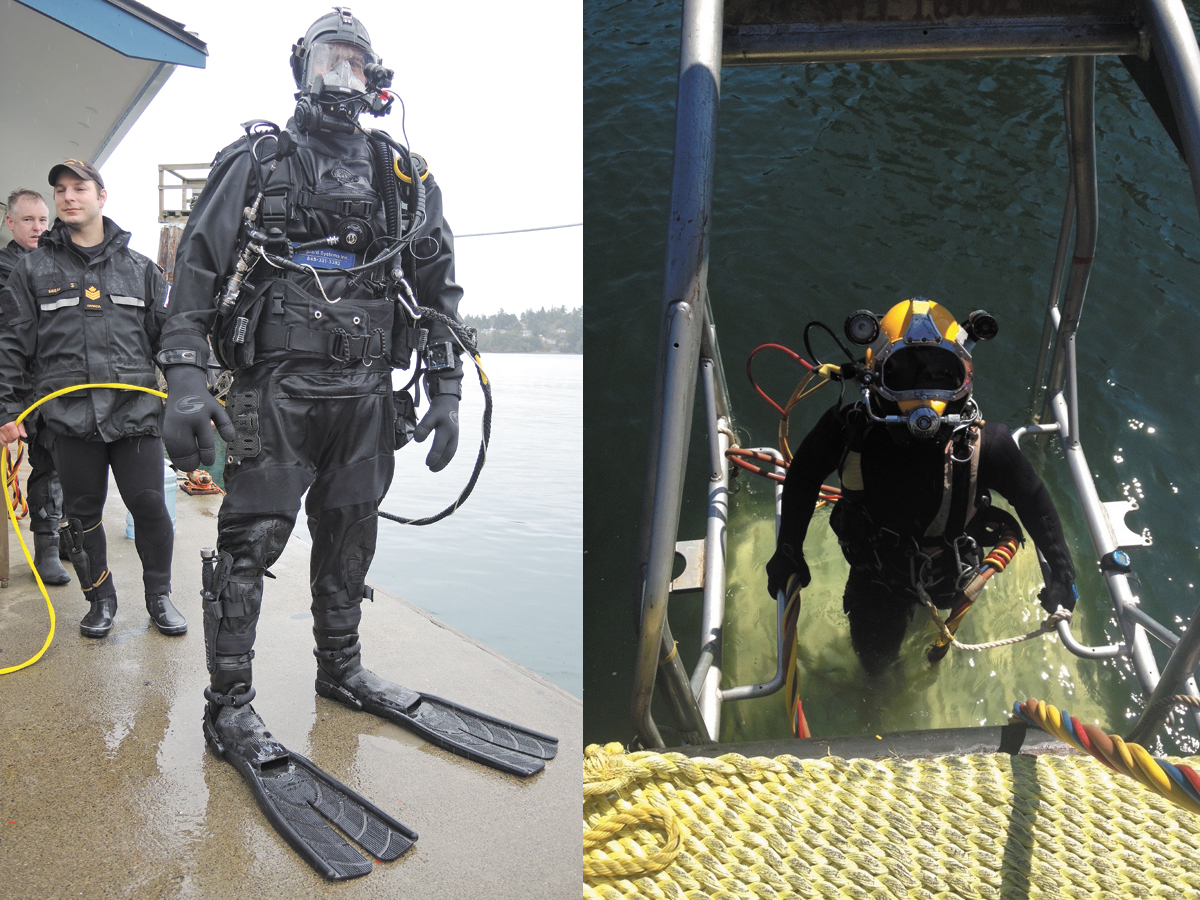Fleet Diving Unit ready for SSBA training
By Lookout on Jun 16, 2020 with Comments 0

The Ultra Lightweight Surface Supply Diving System includes lightweight carbon fiber reserve and regulator tanks, a more portable surface supply system, and a much smaller umbilical cord – the long yellow hose that supplies divers with an unlimited supply of high pressure breathing gas, along with an enhanced communication system. During the training, divers will also wear the Kirby Morgan Super light 17 breathing helmet. Photo: FDU(P)
Peter Mallett, Staff Writer ~
Members of Fleet Diving Unit Pacific (FDU(P)) are set to resume exercises for Clearance Diver and Clearance Diving Officer students next weekend.
The Colwood-based unit of Maritime Forces Pacific (MARPAC) will host its first clearance diver training exercise since physical distancing orders were implemented in March surrounding the COVID-19 pandemic.
The Surface Supplied Breathing Apparatus (SSBA) training exercise will take approximately three weeks to complete. On the roster are 10 students from across Canada. They are currently in the midst of a 12-month-long certification process to complete their initial and Director Level Training.
Lt(N) Daniel Hawryluk, FDU(P) Director Diving Safety, says clearance diving is a completely new skill set for them. The training is intensive, complex, and difficult to re-start under COVID-19 protocols.
“There are unique challenges that we as divers face when attempting to comply with social distancing in our job, and so putting together a plan to return to training was no small task and will likely require some adjustments as we put it into action,” he said. “These are unprecedented times and we have to be adaptable, but in the end we will find a way to get the job done, we always do.”
As required by CAF COVID-19 health and safety regulations, visiting trainees will self-quarantine for 14 days. They will be tested for the virus on a regular basis before they gather for their first orientation meeting on June 22.
Despite the precautions, Lt(N) Hawryluk says a fair degree of anticipation and excitement surrounds the resumption of training for himself, the sailors, and three other instructors from his unit.
Trainees and FDU(P) staff will conduct the exercise in the protected waters of Brentwood Bay, located approximately 20 kilometres north of CFB Esquimalt. The group will sail to the location aboard Queen’s Harbour Master vessels YTD 11 and YTD Sooke, which will also transport their equipment and a Rigid-Hulled Inflatable Boat.
Under the supervision of an instructor, trainees will dive to a depth of approximately 90 meters. Equipped with hand tools, their objective will be to make repairs to a metal box with several holes, using a variety of patches including coffer dams, plates, clothes, and rubber plugs.
Submerged divers will be attached to the SSBA through a tether that contains communication lines, an airway for breathing, audio and video, and a supply of warm water to their suits to combat cold water temperatures.
Divers will be rigorously tested in gas blending procedures with the SSBA to avoid the risks of decompression sickness. This will require them to achieve the correct mixture of gasses – nitrox,and heliox – at various depths.
Divers will also use the on-board recompression chamber to conduct surface decompression and avoid the health risks of ascending too quickly, also commonly referred to as ‘The Bends’. They will use the Kirby Morgan Super light 17 breathing helmet. The helmet is designed to enhance diver breathing at a variety of depths and is the same style of helmet used by navy Clearance Divers in the recovery of Swissair Flight 111 in 1998.
After they have successfully patched the metal box so it is air tight, and completed their training, they will move on to the next phase. It will involve pumping the patched metal box full of air and floating it to the surface, a procedure similar to many salvage operations. That portion of the training will take place aboard the same dive tenders from July 13 to 24 in a yet-to-be-determined location off southern Vancouver Island.
––––
Filed Under: Top Stories
About the Author:





